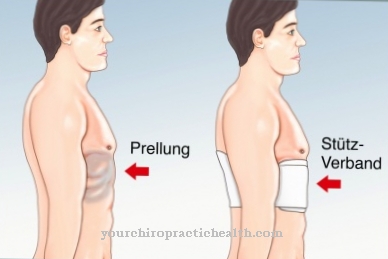As Nephrectomy is called the surgical removal of a kidney. Possible indications for surgical removal of the kidney are kidney infarction or an organ malformation.
What is a nephrectomy?

In a nephrectomy, a kidney is surgically removed. The kidneys are designed as paired organs. They are bean-shaped, 10 to 12 inches long and 4 to 6 inches wide. Their weight varies between 120 and 200 grams. The main task of the kidneys is to produce urine. This requires filtration, reabsorption and concentration of the urine.
The kidneys are also involved in regulating the water and electrolyte balance and regulating the acid-base balance. The first nephrectomy was performed on August 2, 1869 by the surgeon Gustav Simon in Heidelberg. Before the operation on humans, Simon had trained nephrectomy on animals several times. With the first nephrectomy, Gustav Simon proved that a healthy kidney is sufficient to take over the urine output. Previously it was believed that humans with only one kidney were not viable.
Function, effect & goals
Renal infarction is an indication for surgical removal of the kidney. Kidney infarction is a necrosis of kidney tissue that has arisen due to circulatory disorders and insufficient oxygen supply (ischemia). The kidney infarction is often caused by a thrombosis.
This can occur due to atrial fibrillation, aneurysms of the heart wall, heart valve replacement or inflammation of the inner lining of the heart. Venous thrombosis can also cause kidney infarction. This is usually due to right heart failure. Another possible cause is the compression of the renal veins by a kidney tumor.
Another indication for a nephrectomy is recurrent kidney inflammation (nephritis). In nephritis, the functional kidney tissue and the renal pelvis are usually inflamed. Most of the time, nephritis occurs as a result of infections rising from the urinary tract. Kidney and urinary stones, diabetes mellitus, malformations and abuse of painkillers have a beneficial effect. Severe cases of kidney stones (nephrolithiasis) may also require removal of the kidney.
Nephrectomy may also be indicated for hydronephrosis. Hydronephrosis is a pathological enlargement of the renal pelvis. This enlargement leads to a urinary flow disorder. The renal pelvis is inflated, but the renal parenchyma is narrowed. This phenomenon is also known as the water sac kidney. Hydronephrosis can be congenital or acquired. Causes of secondary, i.e. acquired, hydronephrosis are blockages of the urinary tract with stones, carcinoma of the ureter, diseases of the female genital organs or diseases of the urinary bladder.
Serious organ malformations also require a nephrectomy. The same is true for malignant kidney disease. Kidney tumors are often incidental findings. Roughly 90 percent of all malignant kidney tumors are renal cell carcinomas. Benign tumors or so-called oncocytomas are less common.
Larger or centrally located tumors are removed as part of a radical nephrectomy. In a radical nephrectomy, the entire kidney is removed. The procedure can be open surgery or laparoscopically. Until a few years ago, open radical nephrectomy was still the treatment method of choice for kidney tumors. Today laparoscopic nephrectomy is preferred. Open surgery is performed when laparoscopic removal is not possible due to the size of the tumor or previous surgery.
The operation can be performed in the hyperextended lateral position (retroperitoneal) or in the supine position via an abdominal incision (transperitoneal). The kidney vessels are pinched off so that the blood supply is interrupted.Then the kidney is removed together with the fat capsule. The lymph nodes and adrenal glands may also be removed. The adrenal gland sits on top of the kidney. In contrast to the kidney, it is not responsible for urine but for hormone production. Usually, patients can be discharged after 8 to 10 days after a nephrectomy.
Risks, side effects & dangers
An operation, and therefore a nephrectomy, is always associated with risks. During the operation, the cardiovascular system may be disturbed.
Since the anesthetic switches off the protective reflexes of the body, stomach contents can get into the throat, the windpipe or the lungs under unfavorable conditions. This can lead to so-called aspiration pneumonia. During the intubation at the beginning or during the extubation at the end of the anesthesia, a cramp of the glottis can occur in rare cases. The neck and vocal cords are irritated through the endotracheal tube or larynx mask. Therefore, hoarseness and coughing can occur after the operation. In rare cases, damage to the vocal cords may remain.
Occasionally, the front teeth of the upper jaw are damaged when the laryngoscope is inserted. 20 to 30 percent of all patients also suffer from nausea and vomiting after anesthesia.
Even if only a small scar may remain after the operation, a period of rest and recovery of 4 to 6 weeks after the operation is necessary. The risk of thrombosis is increased during the first 4 to 6 weeks after the operation. Pain in the hip, leg or ankle and swelling of the legs should always be seen as warning signs. A life-threatening pulmonary embolism can develop as a result of the leg vein thrombosis.
After the nephrectomy, the remaining kidney must compensate for the loss of kidney function. Therefore it usually increases. This process usually runs smoothly. Nevertheless, the laboratory values should be checked regularly by the doctor. In particular, the glomerular filtration rate (GFR), creatinine clearance and creatinine level should be monitored. Monitoring by the internist is also recommended. If the function of the individual kidney is impaired, the doctor can initiate dialysis in good time.





.jpg)






.jpg)

.jpg)
.jpg)











.jpg)